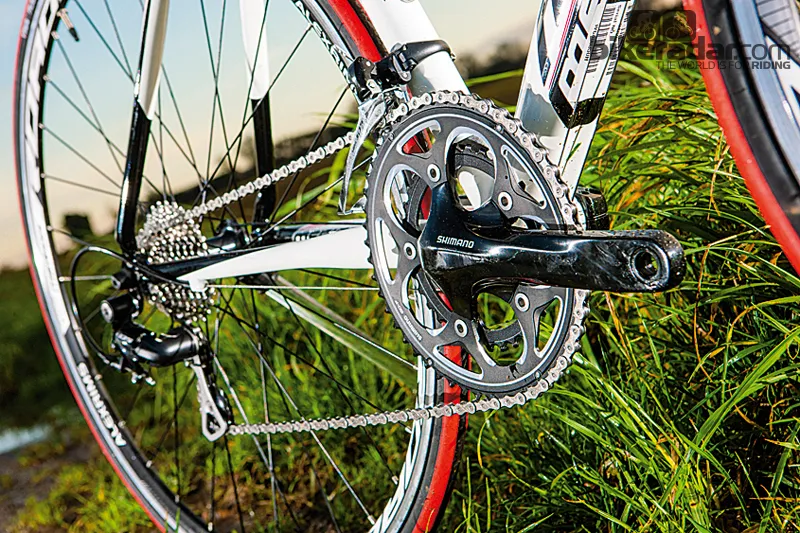Merida have a lot in common with Giant. But in Europe, they don’t share the same profile as Giant or some of the other major brands. That may change in 2013, when they achieve an ambition to sponsor a top-level professional road team, supplying bikes to the Italian Lampre squad.
Merida also have strong links with Specialized, owning a third of the American company. On paper their Race Lite 900 – the cheapest of their 19 road bikes – offers a lot of bang for your buck.
Ride & handling: Quick to respond to rider input
The Merida has pretty racy geometry. It’s got a short 16cm head tube, 73-degree head angle, 73.5-degree seat angle and short 405mm chainstays (15mm less than the Giant’s), but it’s also got that massively tapered steerer tube with its 1.5in lower bearing race. This really does make it the machine for the aspiring racer.
Throw it into corners with vim and vigour? No problem. Out-of-the-saddle, pull-up-on-the-bar sprints? Not a murmur of complaint from the totally convincing front end. Take the spacers out and you can get into a nice low position on the drops or tri-bars too.
The shorter rear-end makes the whole bike pretty snappy and quick to respond to your input. Its racy 12-25 cassette could mean you’re out of the saddle on steeper slopes, but even high torque efforts were tackled without any rear brake rub – the chunky chainstays and seatstays keeping unwanted flex down to a minimum.
But while the frame is stiff and aggressive, it does balance this with reasonable comfort too. The semi-compact frame doesn’t expose as much seatpost as a more compact frame like the Giant, but the seatpost is a standard 27.2mm which combines with a good, own-brand saddle to insulate you from the worst effects of a stiff aluminium frame and potholed roads.
If you’re looking for speed on a budget you won’t be disappointed with the Merida – whether you’re after a high-end training bike or your first racing bike.

Frame & equipment: Sophisticated frame and fork combo for the price
The Merida’s frameset is a star at this price. “Designed in Europe, handmade in Taiwan”, says the label, and Merida’s continents-traversing team has done a top job. It’s exceedingly well finished, but beneath that glossy exterior there’s a lot going on too. It’s made from smooth-welded, triple-butted 6066 aluminium – it’s not that long ago that hydroformed triple-butted tubing was only seen on cycling exotica. The rear brake cable is routed through the inside of the frame.
The top tube has a diamond profile at the head tube, narrowing and morphing into an inverted triangular profile as it reaches the seat tube. The large down tube has a rounded trapezium profile with a groove along the centre of the underside, or ‘Shotgun’, as Merida’s marketing people would have it – though we’re not convinced you can feel the difference compared with a round tube.
The fork is another standout product. Not only is the 900 one of the cheapest bikes to boast a full-carbon fork, but the steerer has a massive 1.5in lower bearing too – again usually the preserve of much more expensive bikes.
There aren’t many surprises when it comes to kit. Shimano’s 2300 groupset (the rear mech upgraded to Sora) and FSA Tempo compact chainset are par for the course. It is a bit of a shame that on such a racy frame you can’t change gear while riding on the drops, but shifting is consistent and accurate.
Elsewhere, a lot of care and attention has gone into speccing the bike. There’s a chain catcher to prevent the chain falling off the inner chainring. It doesn’t happen often but when it does it’s awkward, and the tiny weight penalty is worthwhile. There are also frame protectors on the head tube and drive-side chainstay.
There’s a wide, load-spreading seatpost collar and we also like the seatpost’s twin saddle bolts. These offer more security than a single bolt and allow more precise adjustment.
The brakes are slightly less impressive. Not only are they a non-cartridge design, they also require a spanner rather than the usual hex key. It’ll be a cheap and easy upgrade later, but it’s still a surprise considering the rest of the kit.
The Alex rims and Shimano hubs are typical of £600 road bikes. They’re not light, but roll well enough and are straightforward to service. Maxxis’ Rouler tyres have a 120TPI casing, which makes them more supple than most budget road rubber, though at 23mm they don’t contribute much in the way of comfort.
This article was originally published in Triathlon Plus magazine, available on Zinio.



